What does King Charles do and how will duties change on return after cancer treatment?
- Oops!Something went wrong.Please try again later.
- Oops!Something went wrong.Please try again later.
- Oops!Something went wrong.Please try again later.
King Charles is beginning to return to public duties as he continues to be treated for cancer.
Doctors are sufficiently pleased with his progress to enable the King to return to some public-facing work.
Buckingham Palace said the King is "greatly encouraged" to be resuming public duties, which will begin with a visit to a cancer treatment centre alongside Queen Camilla on 30 April.
The King stopped most of his public engagements after his cancer diagnosis on 6 February.
The Palace has not divulged what type of cancer the King has, and it is understood there are no plans to share further details.
It was confirmed when he was diagnosed that it was not prostate cancer. The King had previously been rtreated for prostate enlargement.
What duties will the King now carry out?
Buckingham Palace says the King will not be undertaking a full summer programme of engagements, and the pace of his return will be "carefully calibrated".
He is still being treated for cancer and "it is too early to say" how long this will last, although the King's doctors remain "positive" about his continued recovery.
The cancer treatment centre visit with his wife will be the first of a number of public-facing duties the King carries out in the coming weeks, Buckingham Palace said.
The King and Queen will welcome the Emperor and Empress of Japan for a state visit in June.
Any public-facing work King Charles carries out will be announced nearer the time and be subject to doctors' advice.
The King will be able to meet people both indoors and outdoors, and the Palace said "forthcoming engagements will be adapted where necessary to minimise any risks" to his recovery.
His attendance at key summer events such as Trooping the Colour on 15 June, commemorations for the 80th anniversary of D-Day, garden parties in May and Royal Ascot in June, has not been confirmed yet.
The Palace said "planning continues" for ways in which the King and Queen may attend such events, as well as a possible Autumn tour overseas.
Throughout his treatment, the King has held private meetings as head of state and completed official paperwork - work which will continue.
His weekly meetings with Prime Minister Rishi Sunak have continued as well during his initial period of treatment although not all have been in person.
King Charles made his first major public appearance since the diagnosis on Easter Sunday when he and the Queen greeted crowds after a church service in Windsor.
Which Royals are able to step in for the King?
While the King has been recovering, Queen Camilla and other royals have helped with public engagements.
If the King is ever unable to carry out his constitutional duties for a temporary period, two or more of a group of designated members of the Royal Family would be appointed as Counsellors of State, to act in his place.
They could include the Queen, the Prince of Wales, the Princess Royal and the Duke of Edinburgh.
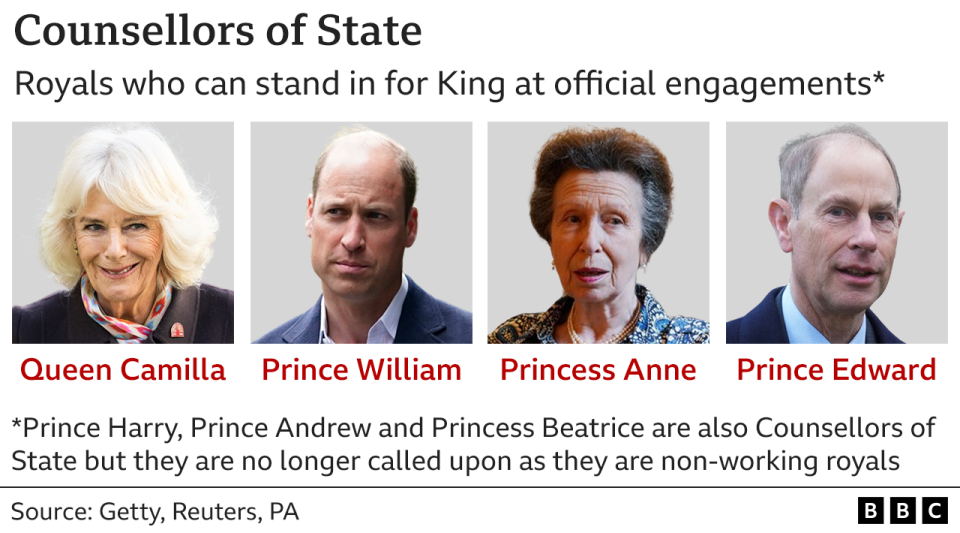
What does the King do?
The King is the UK head of state, but his powers are largely symbolic and ceremonial. He remains politically neutral.
He receives daily dispatches from the government in a red leather box, including briefings ahead of important meetings, or documents needing his signature.
The prime minister normally meets the King on a Wednesday at Buckingham Palace.
These meetings are completely private, and no official records are kept of what is said.
The King also has a number of official parliamentary roles:
Appointing a government - the leader of the party that wins a general election is usually called to Buckingham Palace, where they are invited to form a government. The King also formally dissolves Parliament before a general election
State Opening and the King's Speech - the King sets out the government's plans in a speech delivered from the throne in the House of Lords
Royal Assent - when a piece of legislation is passed through Parliament, it must be formally approved by the King in order to become law. The last time Royal Assent was refused was in 1708
The monarch also leads the annual Remembrance event in November at the Cenotaph in London.
The King hosts visiting heads of state, and regularly meets foreign ambassadors and high commissioners.
In the first year of his reign, the King Charles visited a number of countries, including Germany, France and Kenya.
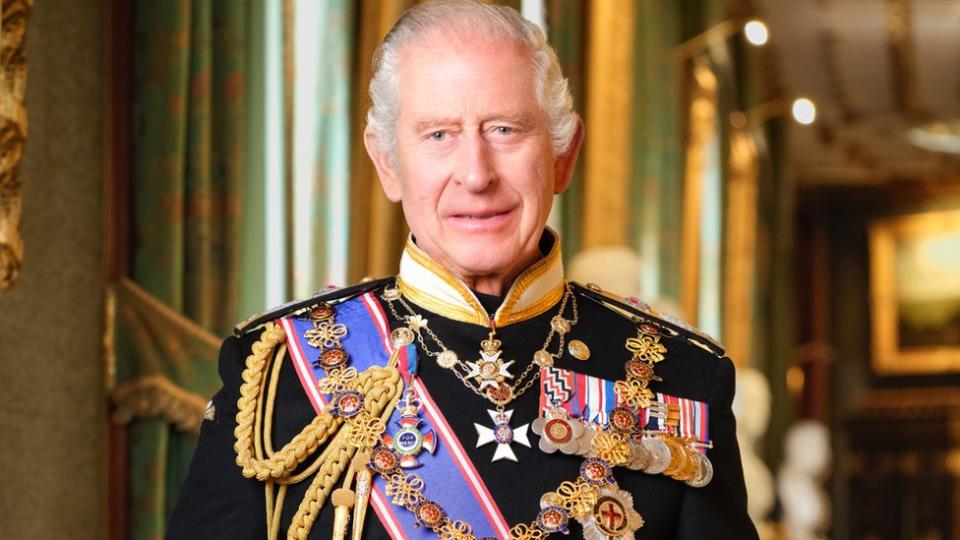
The King is also head of the Commonwealth, an association of 56 independent countries spanning 2.5 billion people.
He is head of state for 14 of these, known as the Commonwealth realms, as well as the Crown dependencies - the Channel Islands and the Isle of Man.
The Queen undertakes her own public engagements on behalf of the 90 charities she supports.
Who else is in the Royal Family?
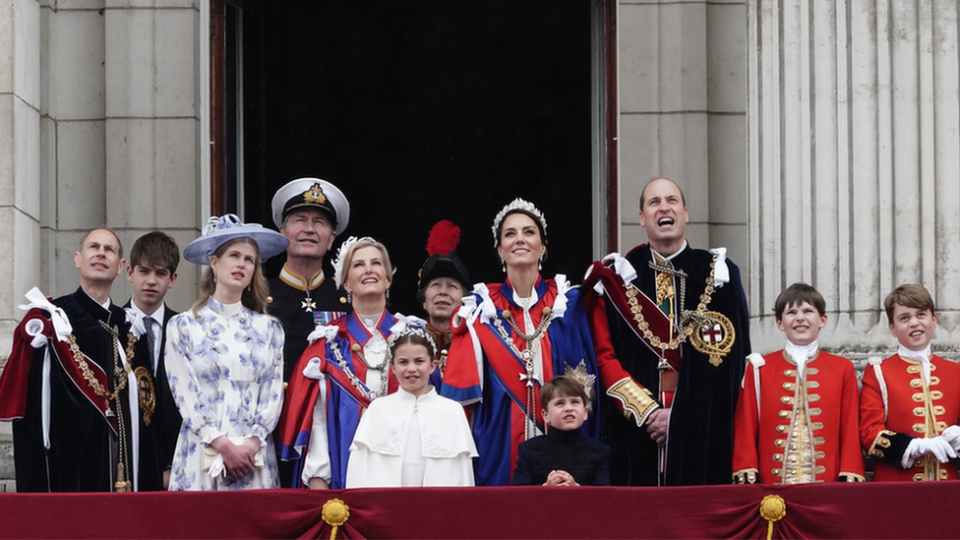
Prince William is the elder son of King Charles and his first wife, the late Princess Diana. After the death of the Queen, he became the Prince of Wales and Duke of Cornwall while retaining his previous Duke of Cambridge title. He is married to Catherine, Princess of Wales and Duchess of Cornwall and Cambridge. They have three children: Prince George, Princess Charlotte and Prince Louis
The Princess Royal (Princess Anne) was the Queen's second child and only daughter. She is married to Vice Adm Timothy Laurence and has two children with her first husband, Captain Mark Phillips: Peter Phillips and Zara Tindall
The Duke of Edinburgh (Prince Edward) was the Queen's youngest child. He is married to the Duchess of Edinburgh (Sophie Rhys-Jones). They have two children: Lady Louise and James, Earl of Wessex
The Duke of York (Prince Andrew) was the Queen's second son. He has two daughters with his former wife, the Duchess of York (Sarah Ferguson): Princess Beatrice and Princess Eugenie. Prince Andrew stepped down as a "working royal" in 2019 after a controversial BBC Newsnight interview about allegations that he had sexually assaulted Virginia Giuffre. In February 2022, he paid an undisclosed sum to settle the civil sexual assault case which Ms Guiffre brought against him in the US
The Duke of Sussex (Prince Harry) is William's younger brother. He is married to the Duchess of Sussex (Meghan Markle). They have two children: Prince Archie and Princess Lilibet. In 2020, they announced they were stepping back as senior royals and moved to California
How does succession work and who is King Charles's heir?
The order of succession sets out which member of the Royal Family takes over as monarch when the existing one dies or abdicates. First in line - the heir to the throne - is the monarch's eldest child.
Sons no longer take precedence over their older sisters.
King Charles's heir is his elder son, the Prince of Wales.
William's eldest child Prince George is second-in-line to the throne, and his daughter Princess Charlotte is third. Her younger brother Prince Louis is fourth and Prince Harry is fifth.

Where does the Royal Family get its money?
The Royal Family receives an annual payment from the taxpayer, known as the Sovereign Grant, which is used to pay for official expenses, such as the upkeep of properties and staff costs.
The amount is based on a proportion of the profits of the Crown Estate, a £16.5bn property business owned by the monarch but run independently.
The Sovereign Grant is worth £86.3m for 2023-2024, as it was in 2021-2022 and 2022-23, although the Royal Family's total spending was more, with the difference covered by reserves.
To keep the annual payment at the same level of £86.3m in 2024-2025, the grant will be a smaller percentage of Crown Estate profits, which have been boosted by six new offshore wind farms.
However, if Crown Estate profits continue to grow as predicted, even under the reduced formula, the amount given to the Royal Family is expected to increase substantially in 2025-2026 and 2026-2027.
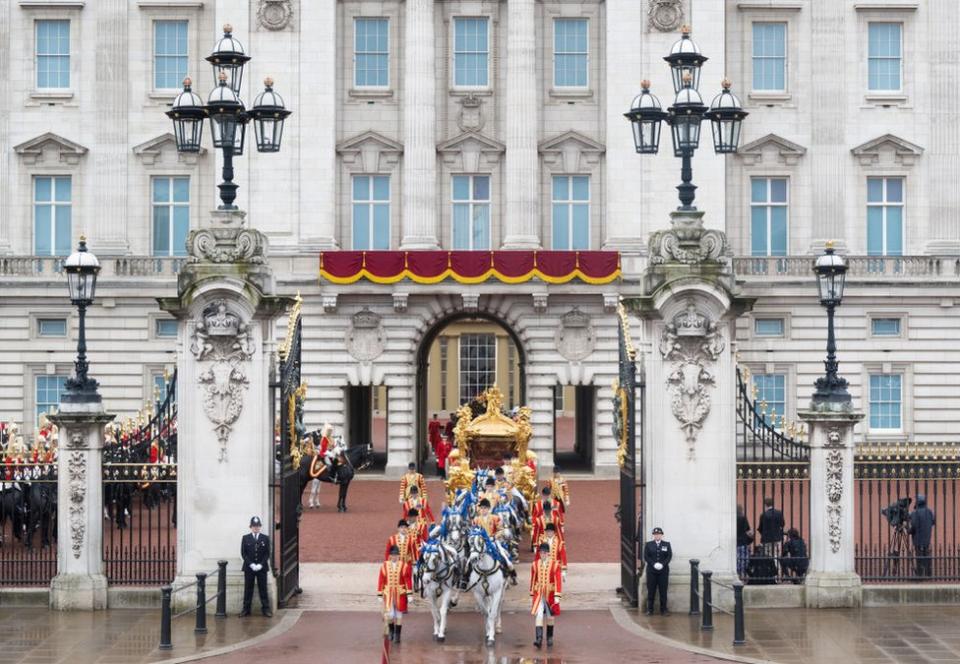
The King also receives money from a private estate called the Duchy of Lancaster, which is passed down from monarch to monarch. It covers more than 18,000 hectares of land, including property in central London. Worth £654m, it generates about £20m a year in profits.
The Duke of Cornwall (currently William, Prince of Wales) benefits from the Duchy of Cornwall, which mainly owns land in the south-west of England. Worth £1bn, it generated a net surplus of £24m in 2022-23.
The King and William receive the profits from the duchies personally, and can spend the money as they wish. Both voluntarily pay income tax on the proceeds.
Some Royal Family members have private art, jewellery and stamp collections which they can sell or use to generate income as they wish.
What happened at the Coronation?
Charles became King on the death of his mother, Queen Elizabeth II, on 8 September 2022.
On 6 May 2023, Charles and his wife Camilla were crowned by the Archbishop of Canterbury in front of more than 2,000 guests, including global politicians, fellow kings and queens, religious leaders, celebrities and community champions.
During the Westminster Abbey ceremony, the King was anointed with "holy oil", and received the orb and sceptre, symbols of royalty.
Crowds lined the streets of central London to watch the King and Queen return to Buckingham Palace in a mile-long procession.
Two months later, the King was presented with the Scottish crown jewels, in a special service of thanksgiving at St Giles' Cathedral, in Edinburgh.
Where do the Royal Family live?
The King and Queen's official residence, Buckingham Palace, is undergoing a 10-year £369m refurbishment,. They split their time between Clarence House in London and Highgrove in Gloucestershire.
Other Royal residences include Windsor Castle, Sandringham, in Norfolk, the Palace of Holyroodhouse, in Edinburgh, and Balmoral Castle, in Aberdeenshire.
In August 2022, the Prince and Princess of Wales moved from Kensington Palace in west London to live in Adelaide Cottage, on the Windsor Estate.
In early 2023, Prince Harry and his wife Meghan were asked to vacate Frogmore Cottage in Windsor, which they had used as their UK base after moving to the US.
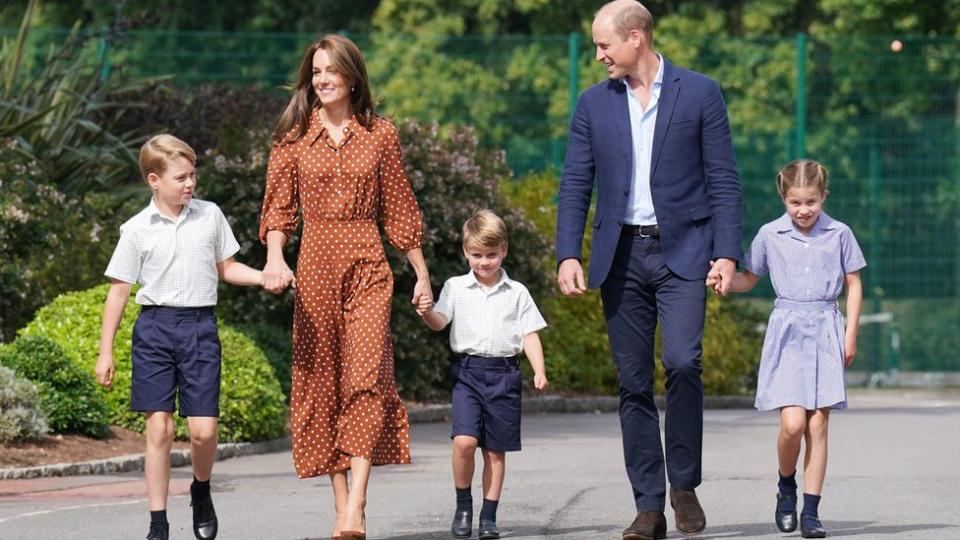
How popular is the Royal Family?
A YouGov opinion poll of more than 2,000 adults in Britain ahead of the first anniversary of Queen Elizabeth's death suggested a sharp generational divide.
Overall, 62% wanted to keep the monarchy, with 26% backing an elected head of state - up from 17% a decade earlier.
But while 80% of the over-65s supported the monarchy, only 37% of 18 to 24-year-olds agreed.
There was also less support for the royals in Scotland or Wales than in England, where London had higher levels of people against the monarchy than anywhere else in the country.

Read the latest from our royal correspondent Sean Coughlan - sign up here.

